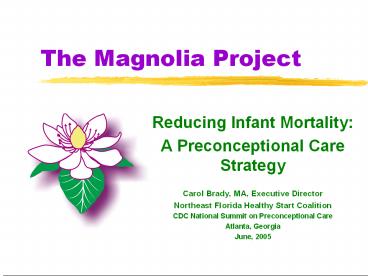The Magnolia Project - PowerPoint PPT Presentation
1 / 21
Title:
The Magnolia Project
Description:
Reducing Infant Mortality: A Preconceptional Care Strategy. Carol Brady, MA, Executive Director ... Infant Care. Black 2.8 White 1.9. R= 1.44 (.092, 2.24 95% C.I. ... – PowerPoint PPT presentation
Number of Views:110
Avg rating:3.0/5.0
Title: The Magnolia Project
1
The Magnolia Project
- Reducing Infant Mortality
- A Preconceptional Care Strategy
- Carol Brady, MA, Executive Director
- Northeast Florida Healthy Start Coalition
- CDC National Summit on Preconceptional Care
- Atlanta, Georgia
- June, 2005
2
A little history. . .
- Duval was one of three counties in 1995-97 that
had an infant mortality rate significantly higher
than the state - Two factors contribute to higher infant mortality
rates in Duval - Proportion of nonwhites in the population
- Poor outcomes among nonwhites
3
Infant Mortality Rates, Duval County, 1993-1998
4
Why focus on well-women?
- PPOR
- Greatest racial disparities occurred in
Maternal Health and Maternity Care - Disparities disappeared in the other categories
- Kitagawa too many black babies born too soon and
too small - FIMR
5
Black White Fetal-Infant Death Rates
By Period of Risk, Duval County 1995-97
Fetal (24 Wks Gestation)
Neonatal
Postneonatal
Maternal Health/Prematurity Black 6.9 White 2.3
R 3.01 (2.14, 4.25 95 C.I.)
500- 1499g 1500g
Maternal Care Black 3.4 White 2.0 R1.70 (1.12
, 2.58 95 C.I.)
Newborn Care Black 1.5 White 1.2 R 1.22 (0.67,
2.20 95 C.I.)
Infant Care Black 2.8 White 1.9 R 1.44 (.092,
2.24 95 C.I.)
Total Feto-Infant Deaths/1000 (Live Births
Fetal Deaths) Black 14.6 White 7.4 R1.96 (
1.59, 2.41 95 C.I.)
6
Linking FIMR to PPOR
- Most Frequent FIMR Factors
- Infections and STDs
- No Healthy Start screening
- Late/inadequate prenatal care
- Previous poor outcome
- Family planning problems
- General state of mothers health
- Poor nutrition
7
From data to action
- Used PPOR FIMR findings to respond to federal
Healthy Start RFP in 1999 to address racial
disparities in birth outcomes - Funded for proposed a Pre- and Interconceptional
Model - Initiated the Magnolia Project
8
The Magnolia Project
- Area accounts for more than half of the Black
infant mortality in the city - About 25,000 women age 15-44 years old live in
the project area
- 85 African-American
9
The Magnolia Project
- Storefront site
- Collaborative effort
- Local Health Department
- Shands Jax
- HS Coalition
- Community agencies
10
The Magnolia Project
- Interventions (1999)
- Enhanced clinical care
- Case management risk reduction
- Outreach
- Community development
- Additions (2001)
- Depression screening
- Health education
11
The Magnolia Project
12
The Magnolia Project
- Case management
- 15-44 and living in target area
- Not pregnant, but sexually active
- 3 or more risk factors previous poor outcome,
repeated STDs, no family planning, substance
abuse, pregnancy
protective services, no source of care
- Clinic services
- Age 15-44
- Resident of target area
- Pregnant or able to get pregnant
- Health exam 1 year
13
The Magnolia Project
- Project experience (2004)
- 800 Women served
- 753 clinic
- 75 case management (3 months)
- 10 pregnant (82)
- 2,260 clinic visits
- 1,264 pregnancy tests (80 negative)
14
Case Management
- 75 served in 2004
- Average length of participation 472 days
- 60 referred by clinic
- Average of 9.2 risk factors/patient
- 54 education/training
- 43 job placement
- 42 family planning issues
- 33 BV
- 24 repeat STDs
15
Case Management for Preconceptional Women
- Approach
- Integrate risk reduction and education into case
management - Visioning for future
- Components
- Assessment of abilities, needs
- Goal setting
- Monitoring and coordination of services
- Anticipatory guidance, education, advocacy role
modeling
16
Case Management
- Priority risks at closure (2001-03)
- 86 of participants with family planning issues
were consistently using a method at closure - 74 of participants with repeated STDs had no
recurrent STDs at closure
17
The Magnolia Project
- Clinical Patient Profile
- 44 sexually active but not using birth control
- 35 STDs
- 20 previous miscarriage or infant death
- 25 poor nutrition (obesity)
18
Infant Mortality Rates, Duval County, 1999-2003
19
Impacting Womens Health Before Pregnancy
- Nearly half of all pregnancies are unplanned
(mistimed or unwanted) - All women age 15 - 44 should be considered
pre-/interconceptional!
20
Taking Action (What Can You Do Without 1
Million.)
- Prenatal care starts at first postpartum visit!
- Integrate womens health assessment, primary care
and risk reduction into current activities - Healthy Start postpartum case management
- MomCare FP waiver integration
- Family planning (birth control vs. health care)
- STD clinic
- Pediatric care
- Other opportunities?
21
Need to expand focus health before pregnancy
impacts prematurity, poor birth outcomes
There are opportunities in current system of care
for developing interconceptional services































